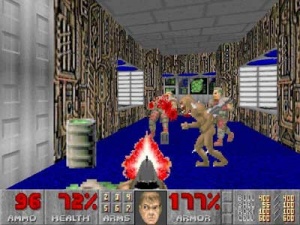Id Software
id Software is a video game development company based in Mesquite, Texas, founded by John Carmack, John Romero, Tom Hall, and Adrian Carmack. The company is known for creating video game series including "Doom", "Quake", "Wolfenstein 3D", and "Hexen". id has come under criticism due to the violent nature of their titles and the potential effects that this violence could have on young people. With their "Doom" series, the company pioneered the idea of allowing users access to design tools in order for them to create their own maps.
Contents
History
After the release of their first title, Commander Keen, id released its first effort into the First Person Shooter genre of videogames. Wolfenstein 3D is widely recognized as the first title in the history of first person shooter (FPS) computer games. The title was among the first of games to have pseudo-3D graphics.
DOOM, id Software's next title, was released on December 10, 1994 to critical acclaim. Its advanced graphics, innovative game play, and the ability for users to create their own levels ("mods") contributed to the title's popularity world-wide.Success with the FPS genre continued with the Quake series, along with sequels of the Wolfenstein and DOOM series. With these titles, the audio and visual aspects of these virtual worlds have become more realistic, along with increasingly sophisticated elements of gameplay.
Released Titles[1]
| Year | Title |
| 1990 | Commander Keen: Invasion of the Vorticons |
| 1991 | Commander Keen: Keen Dreams |
| 1991 | Rescue Rover |
| 1991 | Rescue Rover II |
| 1991 | Dangerous Dave in the Haunted Mansion |
| 1991 | Hovertank 3D |
| 1991 | Catacombs 3D |
| 1992 | Wolfenstein 3D |
| 1992 | Wolfenstein 3D: Spear of Destiny |
| 1993 | DOOM |
| 1994 | Heretic |
| 1995 | Hexen |
| 1995 | DOOM II |
| 1996 | Quake |
| 1997 | Hexen II |
| 1997 | Quake II |
| 1999 | Quake III Arena |
| 2003 | Wolfenstein: Enemy Territory |
| 2004 | DOOM 3 |
| 2005 | DOOM 3: Resurrection of Evil |
| 2005 | Quake 4 |
| 2005 | Enemy Territory: Quake Wars |
| 2007 | Return to Castle Wolfenstein |
Modding and Open Source Game Engines
As stated by John Carmack, a founder of id, in a Slashdot interview, "DOOM was designed from the beginning to be modified by the user community."[2] In 1997, the source code for Doom was released, which allows for programmers to create not only their own levels, but also add their own gameplay. id has been a pioneer in the realm of open source software through its distribution of its game engines' source code.
Whole "modding" communities have sprung up around id's open source engines, with many projects involving antiquated software such as the DOOM source code continuing to be actively worked upon. This has created similar activity around other games, where it is now common for game development companies to release level-creation tool kits for their software.
id Tech 4 engine
Keeping in spirit with id's goal of open sourcing its technology, in November 2011 id open sourced its id Tech 4. This is the powerful engine behind games such as Doom 3.[3]
Controversy and Legacy
As a pioneer in 3D game engines, first person gameplay, and pushing the boundaries of violence in games, id Software has been recognized by its industry as a leader. With the critical acclaim, there has been substantial criticism of multiple aspects of the company's products.
One of the critical elements to id's popular series is the first-person perspective that the player gains. In fact, co-founder John Romero stated on a message board that the protagonist of the DOOM series did not have a name because the player was the protagonist. This perspective, compounded with the amount of graphic violence in the game sparked controversy with the DOOM series, along with the company's other first-person titles. This controversy was magnified when the media reported that the perpetrators of the Columbine High School massacre were avid DOOM players. The game's violent nature, along with being associated to such real-world acts of violence, made DOOM controversial. The ability for a player to immerse himself into the game through creating his own levels and having the first person perspective propelled DOOM to be considered one of the most controversial games of all time. [4]
Ethical Issues
Their games play host to multiple ethical issues.
Violence in Games
Games have the responsibility for the results of how the artificial agents and artificial environments they create affect the ethical mindset of players. In games there is a constant ethical situation where players have choices and have to make them in the virtual world with their interpretation of values in the "real" world. DOOM, Wolfenstein, and some of id's other first-person shooter (FPS) titles are known for their violence, which had relatively high amounts of it when they were first released. Being a virtual reality environment, these FPS games have the ability to encourage "virtue-less" behavior, which has raised the question about how responsible id may be for the real world consequences of in-game violence.
More empirical evidence has been discovered that supports the notion of how violence in video games can encourage users to engage in violence out of the virtual reality.[5] If this is the case, then id Software and other game developers must be prepared to take responsibility for how that violence manifests itself in the real world.
Multi-Player Experience
id has allowed its graphic engines to be used to create users' own virtual environments, in which they can interact with other players through internet connections. The amount of customization available to the modding community permits very unfamiliar environments to be created. The ambiguities created by these capabilities in an online environment make it necessary for id and the user-base to establish guidelines for ethical behavior. Permissible actions (e.g. what can be "killed", created, destroyed, altered) in these environments needs to be commonly understood to prevent harm in this virtual reality [5].
External Links
See Also
Virtual Reality and Computer Simulations
References
- ↑ http://www.idsoftware.com/games/
- ↑ http://infohost.nmt.edu/tcc/soft/carmack.html
- ↑ http://www.shacknews.com/article/71232/doom-3-engine-goes-open-source
- ↑ http://www.huffingtonpost.com/2010/03/12/most-controversial-video_n_496423.html#s69347&title=Doom
- ↑ 5.0 5.1 https://ctools.umich.edu/access/content/group/cd00dd55-2128-45a6-99cb-941eae4d8cda/Required%20Readings/3%20Virtual%20Environments/Brey%20Virtual%20Reality%202008.pdf

